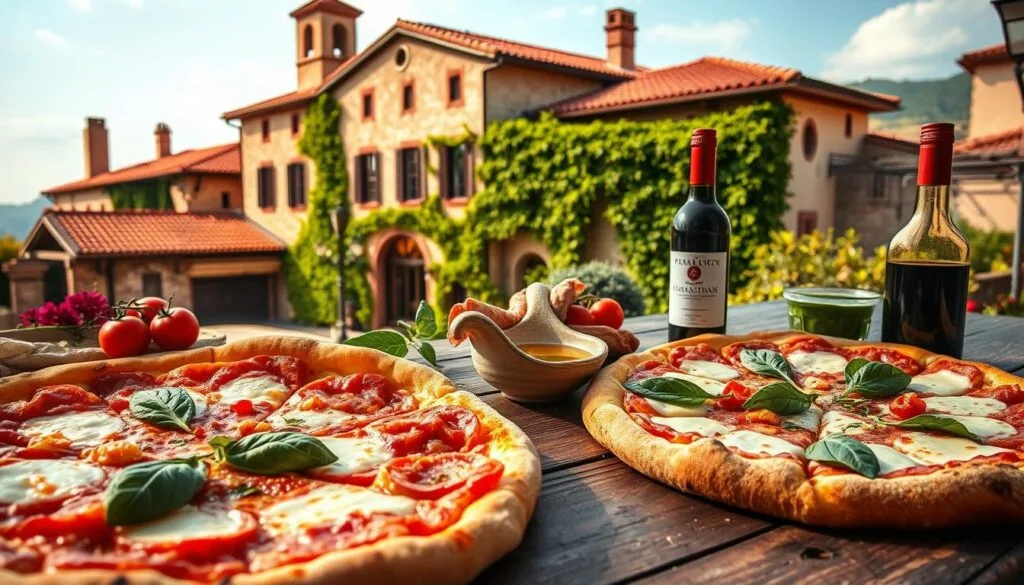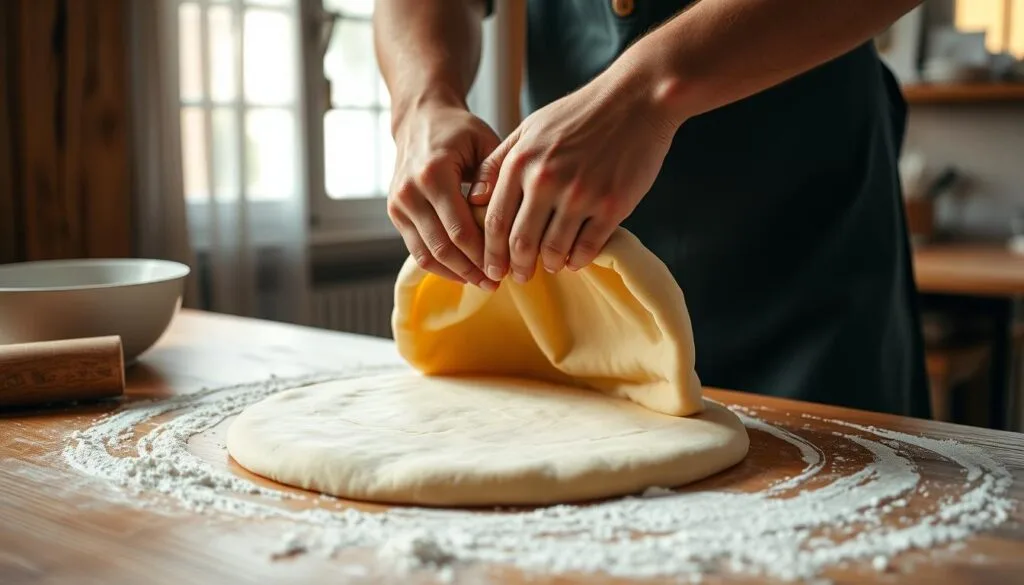
Learn to make authentic pizza italia at home. Italian pizza is more than food; it’s a tradition that turns simple ingredients into amazing meals. You’ll discover how to make pizzas that taste like they’re from a restaurant.
Pizza italia is different from American pizza. It shows Italy’s rich pizza-making culture. You’ll learn about five unique recipes, from Roman-style to Neapolitan, that highlight Italian pizza’s variety.
Start your pizza italia adventure and learn pro techniques and ingredients. You’ll turn your kitchen into a real Italian pizzeria. Get ready for an amazing culinary journey.
Key Takeaways
- Understand the core principles of authentic Italian pizza making
- Learn regional variations of pizza italia techniques
- Master traditional ingredient selection
- Explore five classic Italian pizza recipes
- Develop professional pizza preparation skills
The Authentic Italian Pizza Experience: A Journey Through Tradition
Exploring pizza italia is like starting a food journey that goes beyond cooking. It’s not just a meal; it’s a tradition loved by many for generations.
The tale of pizza starts in Naples. Here, simple ingredients turned into a dish loved worldwide. Local bakers made flatbreads with fresh toppings, laying the groundwork for today’s pizza Italia.
Origins of Italian Pizza Making
Italian pizza making began out of need. Neapolitan workers wanted quick, affordable meals. They made pizzas with:
- Locally grown tomatoes
- Fresh mozzarella cheese
- Basil leaves
- Olive oil
Key Differences Between American and Italian Pizza
| Characteristic | Italian Pizza | American Pizza |
|---|---|---|
| Crust Thickness | Thin and crispy | Thick and doughy |
| Cheese Amount | Minimal | Abundant |
| Topping Variety | Simple, high-quality ingredients | Numerous, often complex combinations |
Regional Italian Pizza Styles
Italy has many pizza styles. Sicilian pizza has a thick, rectangular crust. Roman pizza is known for its thin, crispy crust. Neapolitan pizza is the most traditional, showing the true essence of pizza italia.
Learning about these styles helps us see the rich history behind each slice of Italian pizza.
Essential Equipment for Making Pizza Italia at Home
To make authentic pizza italia at home, you need more than just good ingredients. The right tools can turn your kitchen into a mini pizzeria. This helps you make pizzas that taste like they’re from a restaurant.
Choosing the right tools is key to starting your pizza italia journey. Professional pizza makers know that certain equipment is crucial. It helps make the crust crispy and the flavor delicious.
Must-Have Pizza Making Tools
- Pizza Stone or Steel: Critical for creating crisp, restaurant-style crusts
- Pizza Peel: Helps transfer pizzas smoothly into and out of the oven
- High-Quality Oven Thermometer: Ensures accurate temperature control
- Large Mixing Bowls: Essential for preparing pizza dough
Optional But Helpful Equipment
| Tool | Purpose | Recommended For |
|---|---|---|
| Pizza Wheel Cutter | Clean, precise pizza slicing | Home chefs seeking professional presentation |
| Dough Docker | Prevent air bubbles in crust | Perfectionists wanting uniform pizza base |
| Pizza Screen | Alternate baking surface | Bakers exploring different crust techniques |
Getting quality pizza italia equipment doesn’t have to be expensive. Start with the basics and add more as you get better at making pizza.
Remember, making great pizza is about passion, skill, and the right tools. These tools help bring your pizza dreams to life.
Mastering the Perfect Pizza Dough
Creating authentic pizza Italia starts with understanding the art of perfect dough. Your journey to crafting an incredible homemade pizza begins with mastering the fundamental techniques. These techniques transform simple ingredients into a culinary masterpiece.

The foundation of exceptional pizza lies in selecting the right ingredients and understanding the science behind dough preparation. Let’s dive into the essential elements that make pizza dough truly spectacular.
Understanding Pizza Flour Types
Flour is the backbone of any great pizza dough. For authentic pizza Italia, you’ll want to focus on these key flour varieties:
- 00 Flour: The gold standard for Neapolitan-style pizzas
- High-protein bread flour for extra chewiness
- All-purpose flour as a versatile alternative
The Role of Yeast and Fermentation
Yeast transforms your dough from a simple mixture to a flavorful base. The fermentation process develops complex flavors and creates the perfect texture for pizza Italia.
- Use fresh or active dry yeast
- Allow sufficient time for slow fermentation
- Cold fermentation can enhance flavor depth
Kneading and Resting Techniques
Proper kneading develops gluten, giving your pizza dough the ideal stretch and texture. Follow these key techniques:
- Knead for 10-15 minutes by hand
- Rest the dough for at least 2 hours
- Allow the dough to come to room temperature before stretching
Mastering pizza dough takes practice, but with these techniques, you’ll be creating restaurant-quality pizza Italia right in your own kitchen. The secret is patience, quality ingredients, and a passion for authentic Italian cooking.
Classic Neapolitan Margherita Recipe
The Neapolitan Margherita pizza is at the heart of pizza Italia. It has a rich history, dating back to the late 19th century. Named after Queen Margherita of Italy, it shows the Italian flag’s colors with its ingredients.
To make a true Neapolitan Margherita, you need a few things:
- San Marzano tomatoes
- Fresh buffalo mozzarella
- Fresh basil leaves
- Extra virgin olive oil
- 00 flour for the dough
The key to great pizza Italia is in the making. Your dough should be thin and soft, with a slight edge. It’s cooked in a very hot oven, usually a wood-fired one at 900°F.
| Ingredient | Quantity | Purpose |
|---|---|---|
| 00 Flour | 300g | Base of the dough |
| Water | 200ml | Hydration |
| San Marzano Tomatoes | 200g | Sauce base |
| Fresh Mozzarella | 100g | Primary topping |
Every Margherita pizza should honor tradition. It’s made by hand, topped lightly, and cooked fast. Your aim is to mix flavors in a way that celebrates Italian simplicity.
Authentic Roman-Style Thin Crust Pizza
Roman pizza is known for its ultra-thin, crispy crust. This makes it different from other pizzas. It offers a crunchy texture that pizza lovers enjoy.
To make a real Roman pizza, you need to get the dough right. You want a crust that’s thin but still strong enough to hold toppings.
Achieving the Perfect Crispy Base
Here’s how to make a great Roman-style pizza:
- Use a high-protein flour for elasticity
- Roll the dough extremely thin (almost transparent)
- Preheat your pizza stone or baking sheet to 500°F
- Bake for 8-10 minutes until edges are golden brown
Traditional Roman Toppings
Roman pizza is all about simple yet tasty toppings:
| Classic Topping | Key Ingredients |
|---|---|
| Pizza Bianca | Olive oil, rosemary, sea salt |
| Trastevere Style | Pecorino cheese, black pepper |
| Margherita Romana | Fresh mozzarella, basil, light tomato sauce |
Follow these steps, and you’ll make your kitchen feel like Rome. You’ll create pizza italia that feels like a taste of Rome.
Sicilian Deep Dish Pizza Guide
Explore the world of pizza italia with a Sicilian deep dish pizza. It will change your home cooking. This pizza has a thick, spongy crust that’s both hearty and delicious.
The origins of Sicilian pizza come from Palermo’s lively street markets. It’s different from thin Neapolitan pizzas. Its crust is crispy outside and soft inside, like bread.
- Signature rectangular shape
- Thick, focaccia-like crust
- Generous layer of toppings
- Typically baked in a sheet pan
To make a real Sicilian pizza, you need to learn a few tricks. The dough needs to rise longer. This makes it rich in flavor and spongy.
| Ingredient | Quantity | Purpose |
|---|---|---|
| High-protein flour | 4 cups | Creates sturdy crust |
| Olive oil | 1/4 cup | Adds flavor and crispiness |
| Active dry yeast | 2 1/4 tsp | Helps dough rise |
Traditional Sicilian toppings include sfincione favorites like breadcrumbs, anchovies, and local cheeses. Your homemade pizza will take you to Sicily’s streets with its bold flavors and unique texture.
Fresh Italian Pizza Sauce Secrets
Making an authentic pizza Italia sauce is an art. It turns a simple pizza into a masterpiece. The secret is in the right ingredients and understanding Italian cooking.
The base of a great pizza Italia sauce is top-notch tomatoes. San Marzano tomatoes are the best in Italy. They offer a sweet and tangy taste.
Selecting the Best Tomatoes
- Choose San Marzano tomatoes for authentic flavor
- Look for DOP-certified tomatoes from Italy
- Prefer whole, peeled tomatoes over pre-crushed varieties
Essential Herbs and Seasonings
The magic of pizza Italia sauce is in its simplicity. A few herbs can make your sauce amazing.
| Herb | Flavor Profile | Best Used In |
|---|---|---|
| Fresh Basil | Sweet, peppery | Margherita-style pizzas |
| Oregano | Earthy, slightly bitter | Robust meat pizzas |
| Garlic | Pungent, sharp | Most traditional pizza sauces |
Pro tip: Keep it simple when making pizza Italia sauce. Let the tomatoes’ natural flavors stand out with just a little seasoning.
Conclusion
Your journey through pizza Italia has given you the skills to make your kitchen feel like an Italian pizzeria. You now know how to make pizzas that truly capture the essence of Italian cooking. This includes understanding different regional styles and mastering dough techniques.
Every recipe and technique you’ve learned is more than just a way to cook. It connects you to Italy’s long food culture history. By using these pizza Italia methods, you’re not just making food. You’re keeping alive a rich food tradition that Italian families have shared for generations.
Pizza Italia is all about keeping things simple and using the best ingredients. As you keep practicing, remember that making perfect pizza takes time and passion. Try out different pizza styles, unique toppings, and enjoy making something special in your kitchen.
Your pizza making skills will keep getting better. Keep learning, stay curious, and dive into the world of Italian pizza. Every pizza you make is a delicious tribute to Italy’s amazing food traditions.
FAQ
What makes Pizza Italia different from American pizza?
Pizza Italia focuses on quality and simplicity. It uses less cheese and fresher ingredients. Each component is valued more than the toppings.
Do I need special equipment to make authentic Italian pizza at home?
A pizza stone or steel can help with a better crust. A pizza peel makes transferring easier. A high-temperature oven improves results.
What type of flour should I use for authentic Italian pizza dough?
“00” flour is the best for Italian pizza dough. It makes a soft, delicate crust like Neapolitan pizzas.
How long should I let my pizza dough ferment?
Let your dough ferment for 24 to 72 hours in the fridge. This makes the dough taste better and feel softer.
What are the most traditional Italian pizza toppings?
Traditional toppings include fresh mozzarella, San Marzano tomatoes, and basil. Use extra virgin olive oil and high-quality ingredients that don’t overwhelm the pizza.
Can I make authentic Italian pizza in a regular home oven?
Yes, you can! Use a pizza stone and preheat your oven to 500-550°F. Stretch and top your pizza right.
What is the difference between Neapolitan and Roman-style pizza?
Neapolitan pizza has a thick crust and raised edges. It’s small. Roman-style pizza is thin, crispy, and rectangular. Ingredients and cooking methods vary.
How do I prevent my homemade pizza from becoming soggy?
To avoid a soggy crust, use less sauce and toppings. Preheat your stone or steel. Keep your oven hot. Pat wet ingredients dry and choose less watery toppings.


